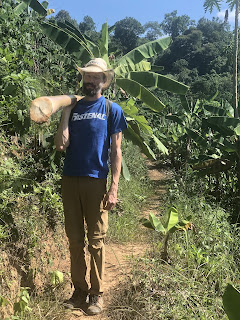The main incentive for this entire SE Asia trip was to come to the
Elephant Conservation Center in Sayaboury, 2.5 hrs south of Luang Prabang (transport involved driving and boat trip). During our travel to the Center we passed by some amazing terrain. Laos is so different from Vietnam. It feels relatively untouched (not destroyed by tourism).
 |
| Arrival to ECC |
 |
| Our ride |
 |
| Laos countryside |
The ECC is home to 12 ECC owned elephants and 12 government owned elephants (rescued from some illegal export operation), on 530 hectares of forested land. Many of the elephants have come from the logging trade (use of elephants for logging is severely restricted now in Laos) or tourism. 6 months ago 5 elephants were released in one of the national parks in Sayabory in approx 188,000 hectares. It is part of a pilot project for a long term slow release program, and one that will hopefully extend to other elephants who have shown their readiness to be able to assimilate into the wild.
50% of elephants on Laos remain in captivity (likely working elephants not in good conditions)
So what does the ECC do here?
- educate the public on issues affecting elephants such as deforestation, man/elephant conflict, poaching, negative long term affects of tourism/logging
- work with mahouts - introducing the idea of soft training and positive reinforcements. Every elephant at the center has a mahout. Some came here with their elephants and others were hired to take care of the resident elephants at the ECC. This is necessary to ensure the safety of the elephants- if they wander into farmland and destroy crops that’s a problem, also there’s not enough forest to release all of the elephants nor have elephants in captivity learned to be properly socialized (as they are purposely segregated so humans can control them with ease) so they can’t be released until they are ready. Some will never be ready and will remain at the Center forever
- elephant hospital - provide free elephant veterinary care to any elephant. Provides encouragement for mahouts to bring in-their elephants for proper care.
- elephant breeding program
- socialization - captive elephants are segregated and therefore, do not know how to socialize. The ECC groups together elephants who get along to make a herd. These elephants come together in the elephant socialization area where they can be free to be themselves without mahout intervention. Socialization is critical for re-hearding and release program.
- enrichments - brain games for elephants. Those who have been in captivity have everything done for them. So enrichments force elephants to find their food which encourages thought and physical activity. Also encourages play for baby elephants
They do so much here. And everything they do is with purpose. Such a great and important facility. We’re here for 6 days volunteering and learning. Facilities are basic but it’s all about the elephants so we don’t mind.
 |
| Our cabin |
 |
| Bridge leading to the bathing area |
 |
| Restaurant, hanging with other Canadians |
 |
| Collecting food for enrichment area |
Fun elephant facts:
- elephants eat grasses, barks, leaves, roots, stem. We fed them lots of banana trees. They also like ice.
- elephants dust off their food before eating by hitting the food against themselves or against trees.
- elephant tusks grow back.
- some people believe elephant dung and urine has medicinal properties. One villager, collects elephant dung, dries it, fries it and makes tea out of it. The diabetes he had his whole life is gone after 3 months of consuming elephant tea and urine. One of the guide's daughters couldn't walk since birth. After a month of drinking elephant tea she can stand up and move a little with support.
- male elephants were used in the logging trade. Male elephants during musth can be dangerous. So in order to control captive male elephants in musth, a drug was administered. One of the male elephants at the ECC had no interest in procreation, and therefore not part of the breeding program. It was thought that this might be due to the effects of the drug that was administered when he was a working elephant in the logging trade.














No comments:
Post a Comment